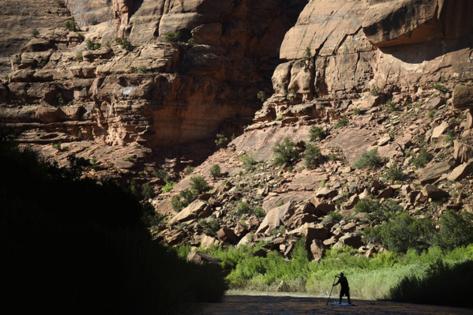Despite Trump's anti-public lands stance, Colorado advocates still hope to protect Dolores River canyonlands
Published in Science & Technology News
Proponents of creating a national monument to preserve one of Colorado’s “last, best wild places” are pivoting on strategy in the face of new President Donald Trump’s hostility to such designations and his plans to instead open more public lands to energy development.
Members of the “Protect the Dolores” coalition had hoped former President Joe Biden would designate the rugged canyonlands along the Dolores River in far-west Colorado as a monument before he left office. While Biden created or expanded 12 monuments during his four-year administration, he did not take action on the Dolores River.
Biden’s lack of action means advocates for the river will now move forward amid a surge of challenges to federal public lands in the West, which cover hundreds of millions of acres of alpine forests and tundra, sagebrush plains, deserts and canyons. In Colorado, the federal government owns and manages 24 million acres of land — about 37,500 square miles — that cover about a third of the state.
State leaders in several Western states, including Wyoming, Utah and Arizona, have sought to wrest control of federal lands in recent years. On Monday, Trump’s newly appointed secretary of the interior ordered a review of national monuments created by previous presidents as well as lands withdrawn from energy and mining development.
With the new administration antagonistic to national monuments, advocates for greater protection of the river and its broader ecosystem will instead pursue the creation of a national conservation area. But they remain optimistic.
“While we may not have gotten a monument designation from the Biden administration, I still think we got something of enormous value: people wanting to come together and figure something out,” said Scott Braden, director of the Colorado Wildlands Project and one of the monument campaign’s organizers. “An enormous amount of ground has been covered. There’s a sense of inevitability around this, that something will happen for the Dolores.”
Conflict over federal ownership of Western land has existed for as long as federal public lands have existed. But the long-simmering conflict is reaching another boiling point as those who want to return federal land to state or private ownership see an opportunity with the Trump administration and a Republican-controlled Congress, public lands advocates said.
“Federal public lands strike at the very core of what it means to be a westerner,” said Chris Winter, executive director of the University of Colorado Boulder’s Getches-Wilkinson Center for Natural Resources, Energy, and the Environment. “So people from all political viewpoints and backgrounds have very strong beliefs about what it means to live here in the West and the impact public lands have on their lives.”
Optimism around the Dolores River
Supporters of broader and more permanent protections for the Dolores River corridor say gaining them is critical. The form they take is less important, Braden said.
Instead of a monument, advocates for the landscape will pursue the creation of a national conservation area. Monuments and conservation areas both allow for a spectrum of protections to be applied within their boundaries and for management by the Bureau of Land Management and the U.S. Forest Service.
A president can unilaterally create a monument, while a national conservation area requires an act of Congress. Colorado’s lawmakers are already pursuing a national conservation area to cover southern reaches of the Dolores River in Montezuma, San Miguel and Dolores counties.
Discussions last year about how the northern reaches of the river in Mesa and Montrose counties should be managed, and whether it needs more protection there, prompted fiery debates and name-calling.
A coalition of conservationists, business owners and recreationists said that making the area into a 400,000-acre monument would better insulate the land from growing recreational use and protect precious ecosystems while also allowing for mining, energy development and grazing in some areas. But some locals worried that a monument designation would draw more people to the sparsely populated area — or would inhibit livestock grazing and the development of a mostly dormant mining industry.
Conversations about the area’s future sparked such passionate debate because it is a special place that inspires deep feelings, Braden said.
“I don’t think it’s hyperbole to say this is a Yosemite or Canyonlands level of specialness,” he said.
All the conversations over the last year have set the scene for more productive discussions about a potential national conservation area as well as different levels of protection for specific parts of the canyons, said Amber Clark, executive director of Dolores River Boating Advocates. The public process that is part of the creation of a national conservation area allows for conversations about which lands should be considered wilderness — where energy development and some types of recreation would be barred — and which could have more relaxed rules.
The monument campaign sparked visits from both of Colorado’s U.S. senators, who last summer committed to working with people in Mesa and Montrose counties “to find a sensible way to protect the Dolores River.”
The campaign also prompted the creation of working groups and town halls, which facilitated important discussions about the future of the river and its canyons.
“I’m an optimist for sure, but I think we have reasons to believe that we can work through that,” Clark said. “We’re all here. None of us are going to go away. We all care about this landscape in different ways.”
Mesa County Commissioner Cody Davis opposed the creation of a monument but supports a smaller national conservation area, he said, because it would create long-term rules about how the land is used. In response to the monument proposal, leaders from Mesa and Montrose counties last year published a plan for a much-smaller conservation area covering 29,806 acres along the river.
A national conservation area designation protects the land from being designated a monument down the road — which would “rip the rug out” from under local communities, Davis said.
“Let’s settle the debate once and for all,” he said. “I think that doing nothing is dangerous.”
Threats from a new administration
Optimism about the future of the Dolores River comes amid larger worry about the future of public lands in the West.
Interior Secretary Doug Burgum‘s order last week to reassess mineral and energy withdrawals on public lands — making them off limits — undermines the lengthy public process that was used to approve them, said Brien Webster, the public lands campaign manager at Conservation Colorado.
Burgum gave staff 15 days to review hundreds of withdrawals and offer opinions.
“Going back and blowing up these processes politicizes our public lands in a way they shouldn’t be, it ignores the stakeholding for these groups, it ignores the hard work that has gone on by agency staff,” Webster said.
One of the Colorado withdrawals finalized during the Biden administration that could be up for review blocked 224,713 acres from energy and mineral development on the Thompson Divide in southwest Colorado.
“We know that’s a place that people love and that Republicans and Democrats and ranchers and recreationists have worked for decades to protect,” said Will Roush, executive director of Wilderness Workshop, one of the lead groups that advocated for the withdrawal of the Thompson Divide from energy development.
Burgum also ordered the review of national monuments designated by former presidents under the Antiquities Act. Presidents have designated 163 monuments across the country, including nine in Colorado, like the Browns Canyon National Monument near Salida and the Colorado National Monument outside Grand Junction. The nine monuments in Colorado cover a combined 490,000 acres.
Biden in 2022 designated the 53,804-acre Camp Hale-Continental Divide National Monument north of Leadville — the latest monument designation in the state.
It’s unclear whether a president can undo a monument designation by a predecessor because the courts have yet to settle the question, said Winter of CU Boulder.
“Thread of resentment” toward feds
Leaders in multiple Western states in recent years have attempted to undermine federal ownership of large parcels within their borders.
“There’s been this thread of resentment toward the federal government over federal ownership of public lands and how they’ve been managed,” Winter said. “While that’s not a majority position, it is a very strong viewpoint held by some people across the West.”
Wyoming state lawmakers are pursuing a resolution demanding that Congress turn over all federal lands and mineral rights to state control, except Yellowstone National Park. The bill presses for control over 30 million acres — about half of the state’s land mass, including Grand Teton National Park — and on Friday passed out of the Senate with a vote of 16-14.
In Utah, state lawmakers introduced a bill demanding that the state co-manage the five national parks inside its borders: Arches, Canyonlands, Bryce Canyon, Capitol Reef and Zion. The bill follows the U.S. Supreme Court’s decision last month not to hear a lawsuit filed by Utah’s top leaders in August, challenging the BLM’s control over 18.5 million acres, or about 28,900 square miles.
The legislatures of several western states filed briefs in support of Utah’s lawsuit, including Wyoming, Idaho and Arizona.
The concept of giving federal land to the states is not new, but the incoming administration’s stances have likely renewed vigor in the movement, said Devin O’Dea, the western policy and conservation manager at Backcountry Hunters and Anglers. The state actions serve as a public relations campaign against federal public lands, he said.
“Legislators are emboldened perhaps to take another bite at the apple again,” he said.
The anti-public lands movement has not reached the mainstream political culture in Colorado, public lands advocates said.
“Colorado thankfully sees its public lands as an asset,” said Kate Groetzinger, the communications director for the Colorado-based Center for Western Priorities. “Colorado is in a good place to protect its public lands, which is more than we can say for other Western states.”
A recent attempt by a group called the Free Land Holder Committee to seize 1,460 acres of Forest Service land in southwestern Colorado — based on the group’s refusal to recognize the legitimacy of the service — was met with fierce resistance from locals, noted Jim Ramey, the Colorado state director for The Wilderness Society.
“That’s a particularly heartening thing for me to see, when the public lands takeover attacks get very loud and serious … that people will show up, arm in arm, and say it should stay public,” he said.
_____
©2025 MediaNews Group, Inc. Visit at denverpost.com. Distributed by Tribune Content Agency, LLC.







Comments